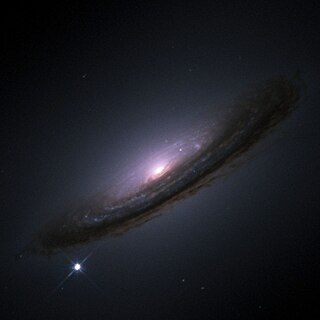
A supernova is a powerful and luminous explosion of a star. A supernova occurs during the last evolutionary stages of a massive star, or when a white dwarf is triggered into runaway nuclear fusion. The original object, called the progenitor, either collapses to a neutron star or black hole, or is completely destroyed to form a diffuse nebula. The peak optical luminosity of a supernova can be comparable to that of an entire galaxy before fading over several weeks or months.
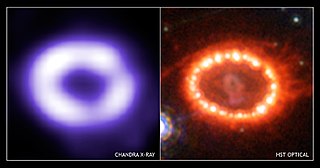
SN 1987A was a type II supernova in the Large Magellanic Cloud, a dwarf satellite galaxy of the Milky Way. It occurred approximately 51.4 kiloparsecs from Earth and was the closest observed supernova since Kepler's Supernova in 1604. Light and neutrinos from the explosion reached Earth on February 23, 1987 and was designated "SN 1987A" as the first supernova discovered that year. Its brightness peaked in May of that year, with an apparent magnitude of about 3.
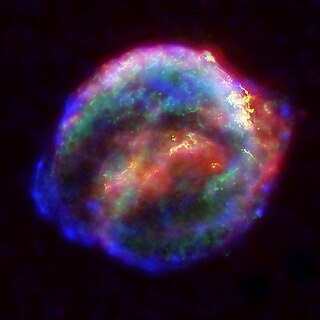
SN 1604, also known as Kepler's Supernova, Kepler's Nova or Kepler's Star, was a Type Ia supernova that occurred in the Milky Way, in the constellation Ophiuchus. Appearing in 1604, it is the most recent supernova in the Milky Way galaxy to have been unquestionably observed by the naked eye, occurring no farther than 6 kiloparsecs from Earth. Before the adoption of the current naming system for supernovae, it was named for Johannes Kepler, the German astronomer who described it in De Stella Nova.
Timeline of neutron stars, pulsars, supernovae, and white dwarfs
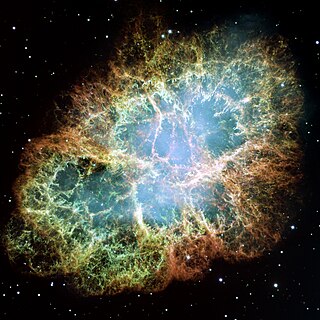
The Crab Nebula is a supernova remnant and pulsar wind nebula in the constellation of Taurus. The common name comes from a drawing that somewhat resembled a crab with arms produced by William Parsons, 3rd Earl of Rosse, in 1842 or 1843 using a 36-inch (91 cm) telescope. The nebula was discovered by English astronomer John Bevis in 1731. It corresponds with a bright supernova recorded by Chinese astronomers in 1054 as a guest star. The nebula was the first astronomical object identified that corresponds with a historically-observed supernova explosion.
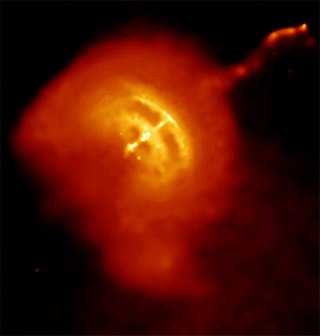
A pulsar wind nebula, sometimes called a plerion, is a type of nebula sometimes found inside the shell of a supernova remnant (SNR), powered by winds generated by a central pulsar. These nebulae were proposed as a class in 1976 as enhancements at radio wavelengths inside supernova remnants. They have since been found to be infrared, optical, millimetre, X-ray and gamma ray sources.
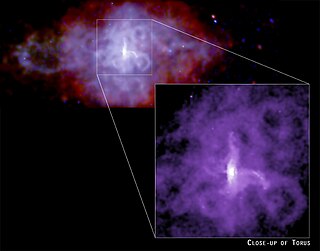
3C 58 or 3C58 is a pulsar and supernova remnant within the Milky Way. The object is listed as No. 58 in the Third Cambridge Catalogue of Radio Sources.
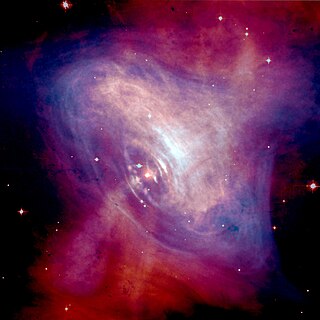
The Crab Pulsar is a relatively young neutron star. The star is the central star in the Crab Nebula, a remnant of the supernova SN 1054, which was widely observed on Earth in the year 1054. Discovered in 1968, the pulsar was the first to be connected with a supernova remnant.
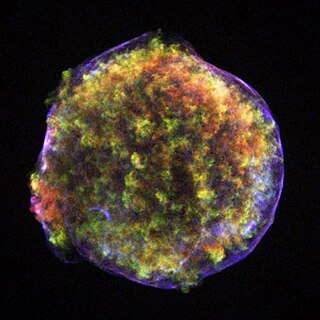
SN 1572, or B Cassiopeiae, was a supernova of Type Ia in the constellation Cassiopeia, one of eight supernovae visible to the naked eye in historical records. It appeared in early November 1572 and was independently discovered by many individuals.

A Type Ia supernova is a type of supernova that occurs in binary systems in which one of the stars is a white dwarf. The other star can be anything from a giant star to an even smaller white dwarf.

IC 443 is a galactic supernova remnant (SNR) in the constellation Gemini. On the plane of the sky, it is located near the star Eta Geminorum. Its distance is roughly 5,000 light years from Earth.

The known history of supernova observation goes back to 1006 AD. All earlier proposals for supernova observations are speculations with many alternatives.

SN 1895B was a supernova event in the irregular dwarf galaxy NGC 5253, positioned 16″ east and 23″ north of the galactic center. It is among the closest known extragalactic supernova events. The supernova was discovered by Williamina Fleming on December 12, 1895 after noticing an unusual spectrum on a photographic plate taken July 18, 1895, and was initially given the variable star designation Z Centauri. The light curve is consistent with an event that began ~15 days before the discovery plate was taken, and this indicates the supernova reached a peak visual magnitude of up to 8.49±0.03.
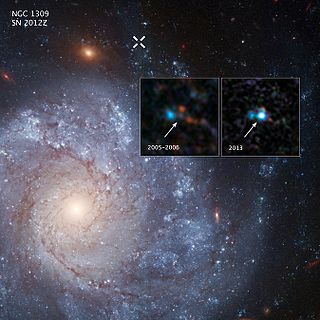
A type Iax supernova is a rare subtype of type Ia supernova, which leaves behind a remnant star, known as zombie star, rather than completely dispersing the white dwarf. Type Iax supernovae are similar to type Ia, but have a lower ejection velocity and lower luminosity. Type Iax supernovae may occur at a rate between 5 and 30 percent of the Ia supernova rate. As of October 2014, thirty supernovae had been identified in this category.
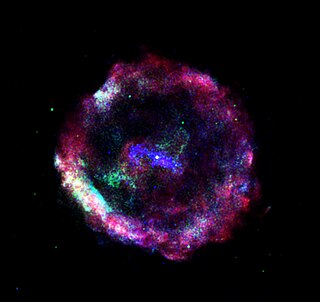
SN 386 is a probable transient astronomical event in the constellation Sagittarius, which appeared as a "guest star" that was reported by Chinese astronomers in 386 CE.

NGC 4424 is a spiral galaxy located in the equatorial constellation of Virgo. It was discovered February 27, 1865 by German astronomer Heinrich Louis d'Arrest. This galaxy is located at a distance of 13.5 million light years and is receding with a heliocentric radial velocity of 442 km/s. It has a morphological class of SB(s)a, which normally indicates a spiral galaxy with a barred structure (SB), no inner ring feature (s), and tightly-wound spiral arms (a). The galactic plane is inclined at an angle of 62° to the line of sight from the Earth. It is a likely member of the Virgo Cluster of galaxies.

IRAS 00500+6713 is the catalogued infrared source for an unusual nebula in Cassiopeia, while the central star has a designation WD J005311, with the whole system designated as Pa 30. The central star and its surrounding shell were created by the supernova seen in the year 1181 as reported by Chinese and Japanese observers. Both the nebula and central star have unique and extreme properties, pointing to their creation by a rare type Iax supernova, where two ultra-dense white dwarfs in-spiral to a collision and explosion. The Pa 30 system was discovered in 2013 by amateur astronomer Dana Patchick, the extreme properties of the central star were first seen in 2019 by Gvaramadze and colleagues, and they recognized that the system was created in a low-luminosity supernova event from a merger of two white dwarfs.
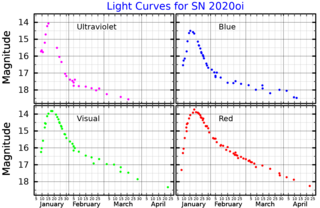
SN 2020oi was a supernova event in the grand design spiral galaxy known as Messier 100, or NGC 4321. It was discovered January 7, 2020 at an apparent magnitude of 17.28 by F. Forster and associates using the Zwicky Transient Facility. The position places it ~4.67″ north of the galactic nucleus. The supernova was not detected on an observation made three days before the discovery, and thus it must have begun during that brief period. The light curve peaked around January 13–18, depending on the wavelength, then declined rapidly over a period of 25 days before flattening into a more gradual decline. Observations of the spectrum made with the SOAR telescope showed this to be a type Ic supernova, with the progenitor being a massive star that had its outer envelope stripped. The initial velocity of the expanding photosphere was ~15,000 km/s.

Kesteven 75, abbreviated as Kes 75 and also called SNR G029.7-00.3, G29.7-0.3 and 4C -03.70, is a supernova remnant located in the constellation Aquila.




















